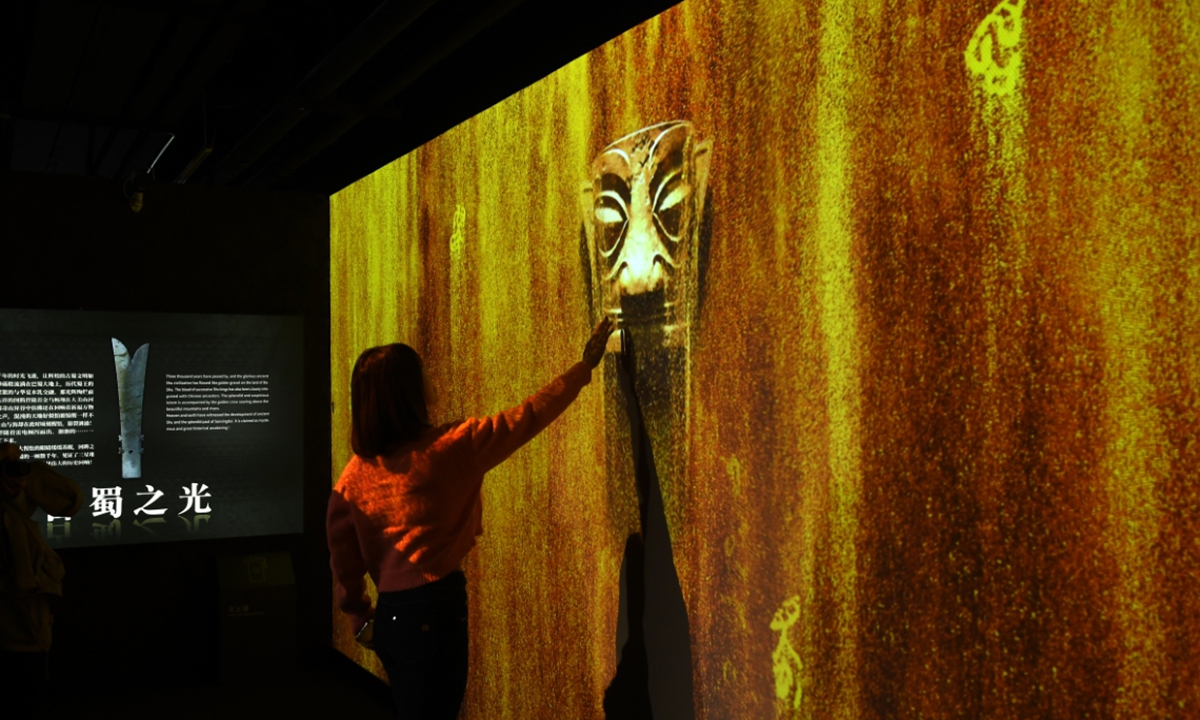
A visitor explores an immersive exhibition of Sanxingdui relics in Beijing on November 18, 2023. Photo: VCG
A digital alliance of cultural heritage institutions was established on Monday in Beijing, a new move aimed at revitalizing cultural relics through technological innovation.
Organized by the Beijing Municipal Cultural Heritage Bureau, the establishment of the alliance saw 15 members, including cultural institutions, media, museums and tech companies, joining hands to build a national and non-profit digital platform that is committed to reviving and enhancing the value of cultural relics through digital means.
By leveraging the power of technology, the alliance will explore new techniques to revive cultural relics, create new models of cooperation and enrich the legacies of artifacts for generations to come.
Shan Jixiang, chairman of the China Cultural Relics Academy and director of the Academic Committee of the Palace Museum, reviewed the road the Palace Museum in Beijing took for the digitalization of the cultural relics in its collection at the launch ceremony.
Shan told the Global Times that using technology is not about showing off and that it's important to combine the preservation of cultural relics with technology to enhance exhibitions.
Leveraging the rich legacies of the Palace Museum, Shan and his team took the initiative to digitize the abundant collection at the museum to better promote the culture surrounding it on social media platforms.
A digital gallery, located at Duanmen Gate, the principal entrance to the imperial palace grounds, was launched in 2015. The gallery hall features screens displaying and explaining architectural features and cultural relics, some of which are too old and fragile for physical display.
"The digital gallery is one of the best digital exhibitions in the world. It's not only technologically advanced, but also displays original works we created based on this rich collection," said Shan.
The gallery offers visitors an opportunity to have a conversation with 1,200 ancient buildings, take a closer look at the designs of 1,500 rare carpets, hand copy an ancient calligraphy work and interact with animals in paintings, Shan noted.
With the help of virtual reality (VR) technology, visitors can "enter" a hall in the Forbidden City that is not open to the public due to preservation concerns and "try on" ancient costumes. Visitors can also use an electronic shuttle to "weave" beautiful designs. The most stunning part is the virtual reality theater, where seven VR films are played on a loop and show visitors some details that cannot easily be seen during a regular visit to the palace, including some bird's eye views of the museum, said Shan.
Luo Jing, head of the Science, Technology and Education Department of the National Cultural Heritage Administration, said at the launch ceremony that the information technology revolution has brought about a tremendous change in people's lives and way of thinking. It has also had an impact on all aspects of cultural professionals.
"The establishment of the alliance is a mechanism that is worthy of recognition," said Luo.
Chen Mingjie, director of the Beijing Municipal Cultural Heritage Bureau, said digitization is one of the most important ways to invigorate cultural relics and innovation is the eternal theme of cultural digitization.
A forum was also held at the ceremony for the stakeholders of the alliance to share their innovative applications and experiences of using digital technology in the fields of cultural relics, archaeology, live performances, game development and video production related to cultural relics.




